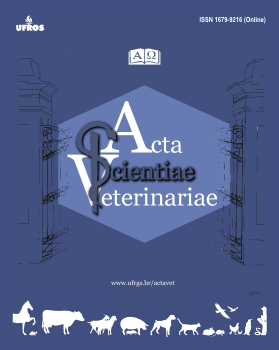Pyometra Treatment by Histeropexy with Toggles Aplication in Mini Horse
DOI:
https://doi.org/10.22456/1679-9216.112268Abstract
Background: Brazil is an important horse breeder that creates about three million jobs and movements about R$16,15billions per year. Although, it is important to the horse breeding industry success that the animals reproductive performance be kept. The mare pregnancy loss causes abundant forfeitures to horse breeders, furthermore, the chronic pyometra is one of that causes. The chronic pyometra is an uncommon mare condition, clinical treatments are often ineffective, under those circumstances the hysterectomy, ovariohysterectomy and uteropexy are recommended. This report proposes to describe the chronic pyometra surgical treatments with the uteropexy technique in mini horses that do not respond to the clinical treatment.
Case: A 14-year-old mini breed horse mare weighing 117 kg was sent to Veterinarian Hospital (HV) of the Paraná Federal University (UFPR), presenting dystocia background and intrauterine purulent secretion. The clinical treatment had been conducted, but not well succeeded. An hysteroscopy was conducted with a cervix rupture monitoring, uterine mucosa edematiated and crispy, presenting liquid and a high amount of purulent secretion in the uterus horn and body. The biopsy identified uteropexy. The post-surgical complications were minimums and 30 days after the procedure the laparoscopy was repeated with uterine healing monitoring, without adherences and the uterus were at horizontal position. The hysteroscopy was conducted where a small amount of purulent secretion was perceived. Ten days after the second laparoscopy the patient was discharged. Two years after the procedure, the animal responsible informed that there was not a relapse.
Discussion: the mare pyometra occurrence is uncommon and emerges by nature protection false mechanisms. Any change or flaw in one of these protection mechanics barriers, may result in a reproductive change due to uterine infection, resulting in reduction of mare reproductive capacity. Probably this reports patients developed pyometra due to the cervix lesion it's presented made easier the uterus external microorganisms entrance, that predisposes an chronic uterine infection. As many authors report, the chronic pyometra clinical treatment is not always successful, also observed in the case reported, indicating then surgical treatment. There are many pyometra surgical treatments indications as: Wedge resection technique in case of cervix adherence, uteropexy technique, ovary-hysterectomy technique or hysterectomy. The ovary-hysterectomy and the hysterectomy was not conducted for being considered highly invasive. This case choice procedure was the uteropexy, which corresponds to fixing the broad ligament of the uterus to the abdominal wall, repositioning it horizontally, to obtain a better drainage and motility, since this is your anatomic position. In the report, the surgical technique was conducted satisfactorily, certifying the uterine elevation by laparoscopy in the postoperative and also by the responsible report, that the animal does not relapse in two years. The postoperative complications were not alarming, considering that it ceased 24h after the procedure. The conclusions present in this treatment show that the hysteropexy conducted by videosurgery with toggles application developed the necessary uterine elevation to the liquid drainage, that allows the mare to execute the uterine cleaning by the physiological form.
Keywords: uterus, endometritis, uteropexy, uterine elevation.
Histeropexia com aplicação de “toggles” para tratamento
de piometra em mini horse
Descritores: útero, edometrite, uteropexia, elevação uterina.
Downloads
References
Auer J.A. & Stick J.A. 2006. Reproductive system. In: Equine Surgery. 3rd edn. St. Louis: Saunders, pp.775-810.
Brin P., Schumacher J. & Schumacher J. 2010. Elevating the uterus (uteropexy) of five mares by laparoscopically imbricating the mesometrium. Equine Veterinary Journal. 42(8): 675-679.
Corsalini J., Gialletti R., Lotto E. & Nannarone S. 2016. Laparoscopic Uteropexy (Mesometrium Imbrication) in Three Mares Using a Barbed Suture. Journal of Equine Veterinary Science. 40: 102-105.
Cozens E.R.W. 2009. Pyometra and complete vaginal adhesion in a miniature horse. Canadian Veterinary Journal. 50(9): 9971-972.
Food and Agriculture Organization of the United Nations. 2016. Live Animals. FAO Global Statistical Yearbook. Disponível em: http://www.fao.org/faostat/en/#data/QA.
Ferreira J.C. & Meira C. 2011. Aplicação da ultrassonografia colorida doppler em programas de transferência de embriões equinos. Ciência Rural. 41(6): 1063-1069.
Freeman D.E., Rötting A.K., Köllmann M., Doyle A.J., Troedsson M.H.T., Pozor M., Lock T. & Stewart A. 2007. Ovariohysterectomy in mares: 17 cases In: Proceedings of the 53rd Annual Convention of the American Association of Equine Practitioners (Orlando, U.S.A.). pp.370-373.
Maia H.G.O., Oliveira N.J.F. & Crocomo L.F. 2019. Fisiologia e fatores interferentes na reprodução de éguas. 29(4): 112-123.
Ministério da Agricultura, Pecuária e Abastecimento. 2016. Defesa Animal. In: Revisão do Estudo do Complexo Agronegócio do Cavalo. Brasília: MAPA, pp.35-54.
Naguib M., Rais B., Adzahan N.M., Mohamad M.A. & Adamu L. 2013. Equine Pyometra: A Case Report. Journal of Agriculture and Veterinary Science. 2(3): 61-63.
Prestes N.C., Erison F. & Rocha M. 2019. Piometra em éguas: causas e desafios do tratamento clinico-cirúrgico. Revista Brasileira de Reprodução Animal. 43(2): 117-121.
Sharma S. & Thapak S. 2010. Chronic pyometra in a throughbred mare. Veterinary Practitioner. 11(2): 116-117.
Published
How to Cite
Issue
Section
License
This journal provides open access to all of its content on the principle that making research freely available to the public supports a greater global exchange of knowledge. Such access is associated with increased readership and increased citation of an author's work. For more information on this approach, see the Public Knowledge Project and Directory of Open Access Journals.
We define open access journals as journals that use a funding model that does not charge readers or their institutions for access. From the BOAI definition of "open access" we take the right of users to "read, download, copy, distribute, print, search, or link to the full texts of these articles" as mandatory for a journal to be included in the directory.
La Red y Portal Iberoamericano de Revistas Científicas de Veterinaria de Libre Acceso reúne a las principales publicaciones científicas editadas en España, Portugal, Latino América y otros países del ámbito latino





